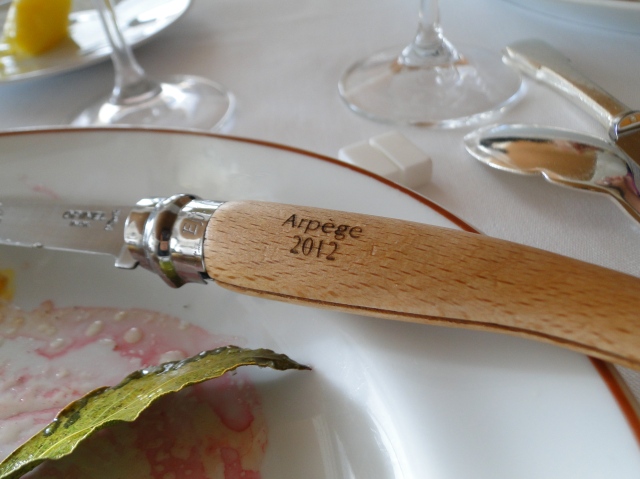 L’Arpege, in Paris, is widely regarded as one of the best restaurants in the world — and probably the best if you’re a vegetarian. The reviews of the place are uniformly glowing. The place can be pricey but is well worth it, at least as a “try it once” experience. Alain Passard has revolutionized haute cuisine for vegetarians, and I hope his philosophy — that gourmet food and vegetarian food don’t have to be at odds — continues to catch on.
L’Arpege, in Paris, is widely regarded as one of the best restaurants in the world — and probably the best if you’re a vegetarian. The reviews of the place are uniformly glowing. The place can be pricey but is well worth it, at least as a “try it once” experience. Alain Passard has revolutionized haute cuisine for vegetarians, and I hope his philosophy — that gourmet food and vegetarian food don’t have to be at odds — continues to catch on.
Before getting into the review, I should explain how Arpege works. First, the restaurant is not totally vegetarian (although you can certainly get a completely vegetarian menu); there are one or two non-vegetarian courses on offer. Meals are prix-fixe (€120 for lunch), nominally for eight courses, though there were many more than just eight.
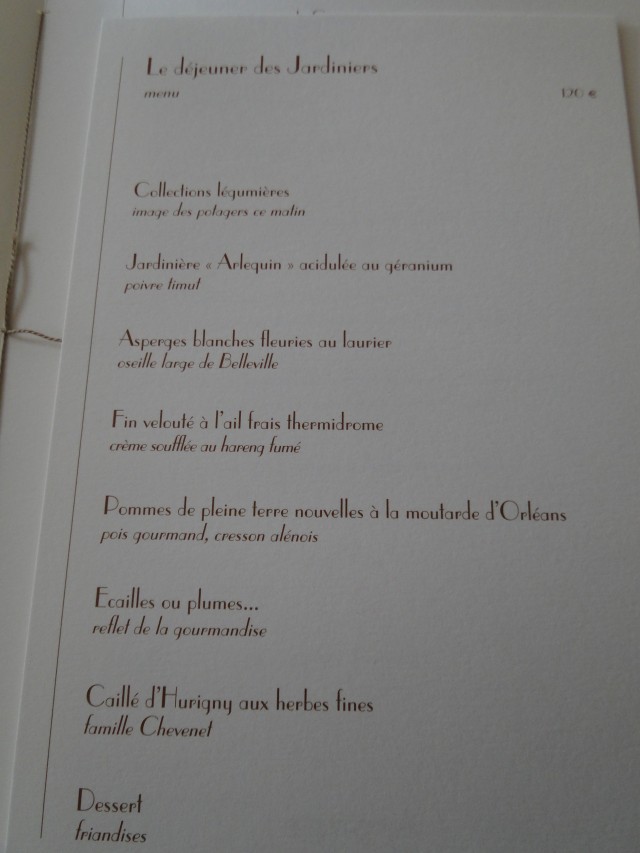 Chef Passard is committed, not only to inventive ways of preparing vegetables, but to fresh, seasonal food. His vegetables are brought in by high-speed train from a farm in upstate France every day, and the day’s menu reflects what’s in season. The upside is that you get great, fresh food. The one downside is that you are limited by what’s available that day.
Chef Passard is committed, not only to inventive ways of preparing vegetables, but to fresh, seasonal food. His vegetables are brought in by high-speed train from a farm in upstate France every day, and the day’s menu reflects what’s in season. The upside is that you get great, fresh food. The one downside is that you are limited by what’s available that day.
Lunch started with an amuse bouche of three tarts. I’ve found that chefs have different approaches to the amuse. Sometimes you’ll see people come out with something totally incongruous with the meal to follow. Chef Passard, on the other hand, used the tarts to foreshadow what was to come. The three tarts were, from left to right, vidalia onion and beet; carrot; and turnip with beetroot. The last one was kind of bitter, though all three were quite good.
Around this time the bread course was served, along with salted butter from Brittany (buerre de Bretagne). This was amazing. I mean life-alteringly amazing. I don’t know how everyone in Brittany doesn’t die of a heart attack by age 25, because if I lived there I don’t think I could stop eating this stuff. (I’m not the only one to rave about the butter.) The butter was amazing. It was incredibly complex, if one can call butter “complex”, and the sea salt took it from great to mind-blowing. For the last 9 months I’ve been debating whether I should try to find it in New York (apparently it’s available in the city); if I did get it, I think I’d become very unhealthy very quickly. Maybe I’ll reserve it as an indulgence for the next time I’m in France…
Bread was followed by onion gratin. This was a thin layer of onion with Parmesan cheese, candied lemon, and greens. The dish was incredible, and tasted like melted onions. If you think that sounds weird, well, you just have to experience it from Chef Passard. As a vegetarian, I generally can’t have French onion soup (beef broth), so this was a nice alternative.
(By the way, for the curious, the wine I was drinking was from Domaine Arretxea, in the Basque region, and was quite good.)
Next up was a “vegetable ravioli soup” in a broth of white asparagus and thyme. This was just one of many courses that mixed the familiar and the unusual. Vegetable ravioli is itself pretty unusual, but to serve it dumpling style in a soup broth was even more so. The ravioli was very good and the thyme gave the soup a subtle touch of flavor that held it all together.
As I mentioned, Chef Passard is known for his inventive ways of preparing vegetables. Here’s an example. This course featured different types of beets (among a few other garnishes; you see the peas on the left and the carrot near the top). Sometimes this dish was sour, sometimes it was sweet, thanks in part to the pool of honey. Some sea salt sprinkled on top was a huge plus, really helping the other flavors pop. I suspect that beets were plentiful that day, because they made several more appearances throughout the lunch — and each time they were different.
The next course was white asparagus. If you’re keeping score, this is the third course listed on the menu — but by now I’ve had the amuse, the bread, onion gratin, ravioli soup, and beets. So the asparagus was in fact the sixth preparation of the lunch, even though it’s number three on the menu. Honestly, it was hard to keep track of exactly what was from the menu and what wasn’t.
The asparagus, mouse, and spinach (that’s the dark-colored stuff on the sides) were all okay individually: a little sweet, a little bitter. The combination, though, was fantastic. This is were Chef Passard and other great chefs excel. As a general matter, none of these ingredients are out of this world. It’s putting them together in ways that you’d never expect that sets the great ones apart. (I had a similar reaction to my recent lunch at Bouley.)
Incidentally, around this time, I switched to a Chateau Beau-Site 2002.
The asparagus was followed by a course of red beets and red onions. I thought this was okay, but it was probably the least impressive course of the lunch. The beets tasted like beets and the onions like onions; I didn’t find anything particularly noteworthy about the dish. Oddly, my wife got garlic soup with herring cream. I understand that you wouldn’t serve herring cream to a vegetarian, but why not just serve me the soup with a different cream?
Next up were new potatoes with snap peas in a mustard sauce. This was a nice, earthy, hearty dish. The other dishes were relatively light, but this one had some heft to it. THat’s not to say it was heavy; the snap peas lightened the potatoes and the mustard sauce added a nice dimension.
By this point I had just completely lost track of where we were in the menu (not speaking French was an added problem). But the next course was a simple preparation of turnip and rhubarb. What really put this over the top was the dill. I’m not sure I’ve ever hard these three ingredients together, but this pulled it off expertly. I liked the crunch of the turnips and the sweetness of the rhubarb.
Turnips are back in the next course, this time in the form of a turnip mousse (top), along with spinach (middle) and candied red onion (bottom). This was another course where the combination of flavors — here, bitter and sweet — really worked. This was also my daughter’s first introduction to turnips. She was about 7 months old at the time, and she couldn’t get enough. She’s never had turnips since, so her one and only exposure has been at a three-Michelin-starred restaurant. I’m sure the next time will be disappointing…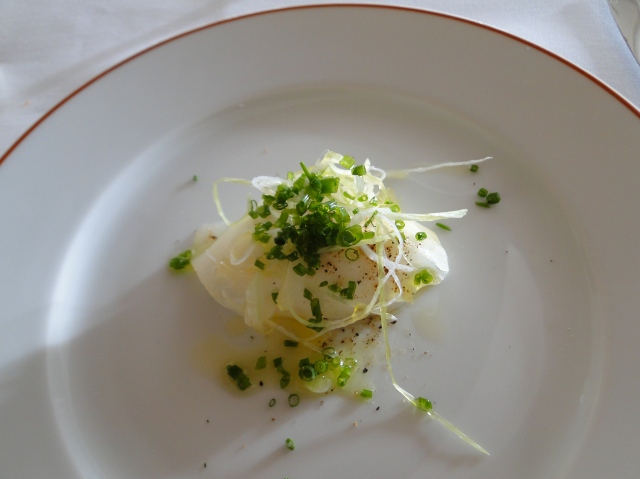
- Goat cheese.
Around this point the “main courses” were over and we started to transition to dessert. First, though, was the cheese course — again with beets. Goat cheese, garlic, and white beets, to be exact. The cheese was smooth, creamy, and savory. The garlic flavor was very light; when I heard the description I was worried that it would be overpowering. The beets were a nice touch.
Dessert was a mille-feuille, which typically alternates layers of pastry with layers of cream. Here, it included mint cream, and rhubarb. It was delicious, so much so that I forgot to take a picture before starting to eat. Oops.
As lunch wound to a close, the waitress brought us some petits fours. Unfortunatley I didn’t take notes on all of the ones that were offered, though the flavors were again innovative and unusual — like cardamom in a macaron! Of course, as loyal readers know, I have a soft spot for apple desserts, so the apple pastry was my favorite:
I can’t imagine how difficult it must be to get such a thin slice of apple spiraled into a pastry shell like that.
Three hours later, over a glass of port and a cup of coffee, I reflected on the meal. I can definitely say it was among the best meals I’ve ever eaten. I liked that the amuse courses neatly foreshadowed the stars of the meal to come. I loved that fresh, seasonal ingredients took center stage, and that meant unassuming players (beets, turnips) took center stage. But even though they made multiple appearances throughout the meal, they never repeated: the same vegetable might be served three or four different ways.
My only quibble, and it’s a small one, is that there was just a large quantity of food. My wife is more emphatic on this point; she says there was so much food that she liked the meal less. And that’s a reasonable conclusion: although the menu lists “only” eight courses, from amuse to petits fours were thirteen different presentations. On the other hand, you’re certainly getting a lot of bang for your € 120! Every single course I had was excellent (except the beets and onions, which were merely “good”). And looking back I see the sheer quantity of work that must go into coming up with so many different colors, textures, flavors, and presentations. The plating is an art form unto itself. But I do wonder if it goes so far that it’s a bit of an overload.
In the end, the courses were all so good that it’s hard to be critical. But the quantity is the one thing that holds me back from saying that this meal achieved culinary perfection.
I heard that Chef Passard was in the kitchen and wanted to talk to him before I left, but unfortunately he had just left the building. But I left my address and he was nice enough to send me a signed menu. Thanks, Chef!
My other keepsake is the knife you see at the top of this post; each year, the restaurant produces a special knife, you use it through your meal, and the waiter cleans and folds it up for you to take home.
As I said, overall, Arpege was fantastic. There’s almost nothing I could say to critique any part of the meal. My word of advice if you’re going to dine here: come ravenous, and pace yourself!
I don’t normally give star ratings to restaurants outside of New York, but I’m making an exception this time: five stars!

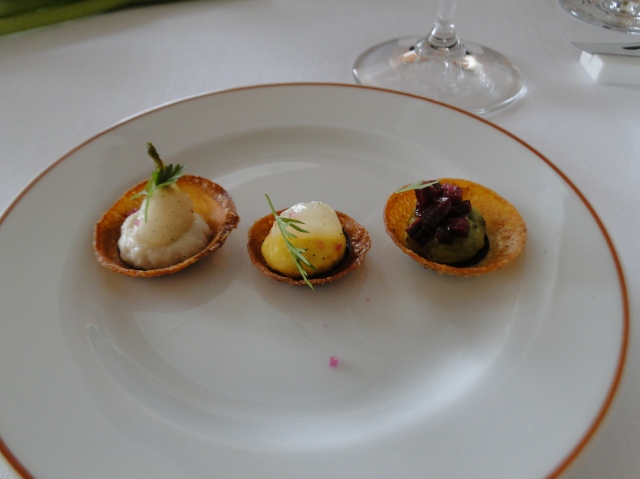
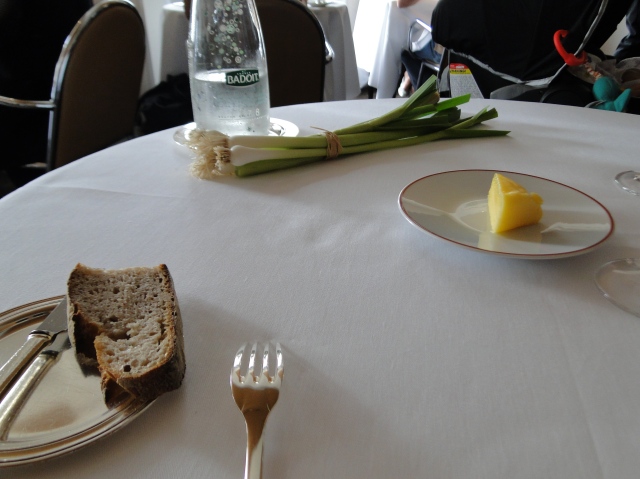
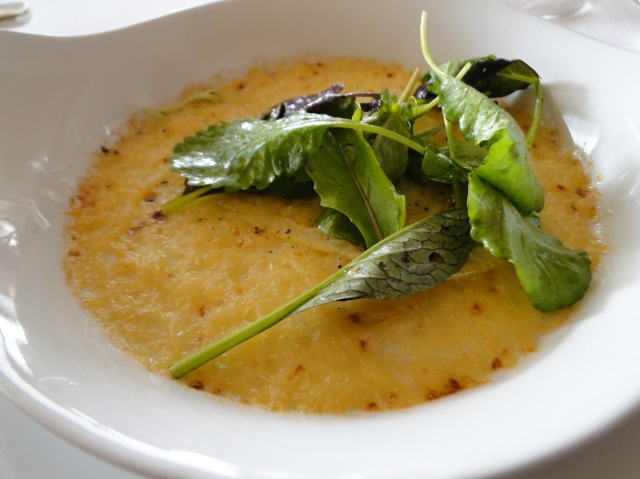
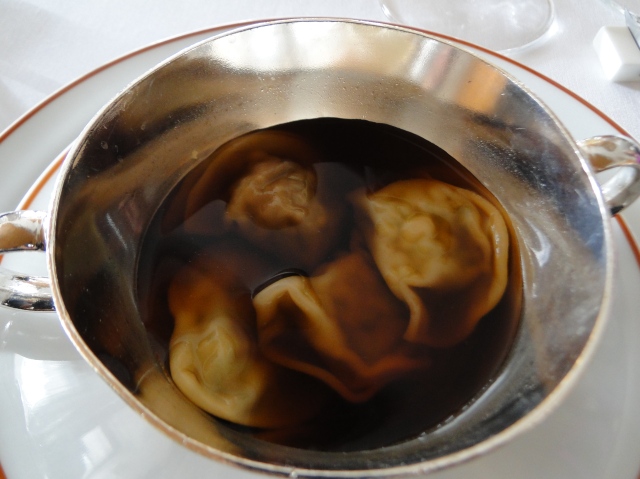
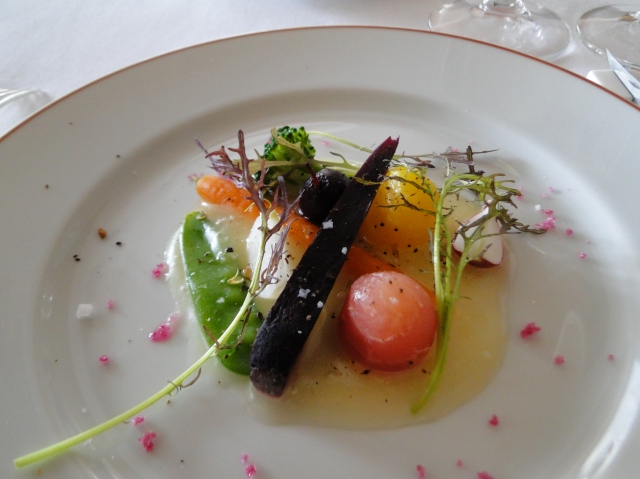
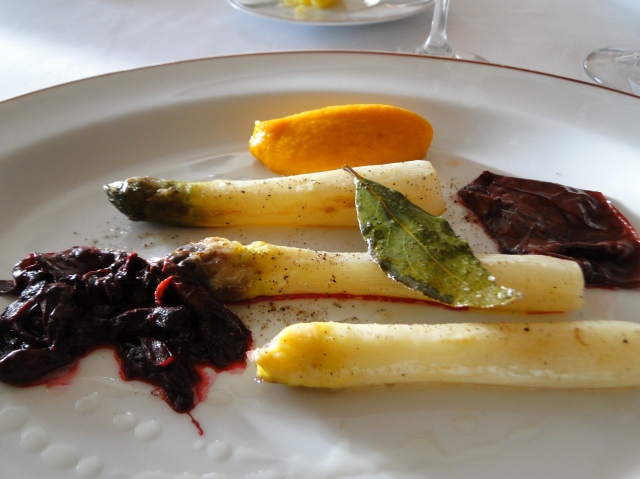
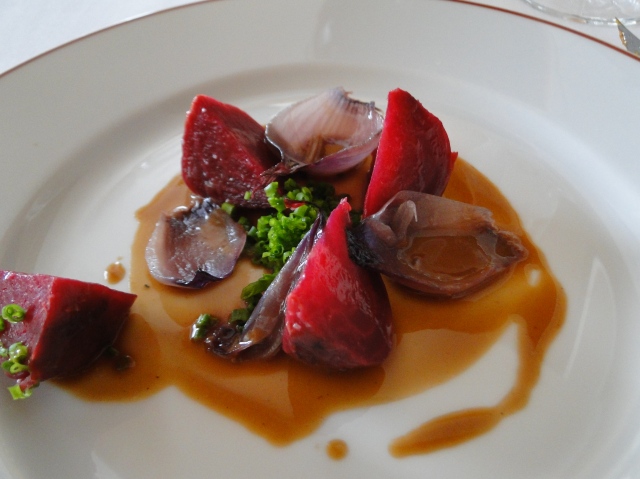
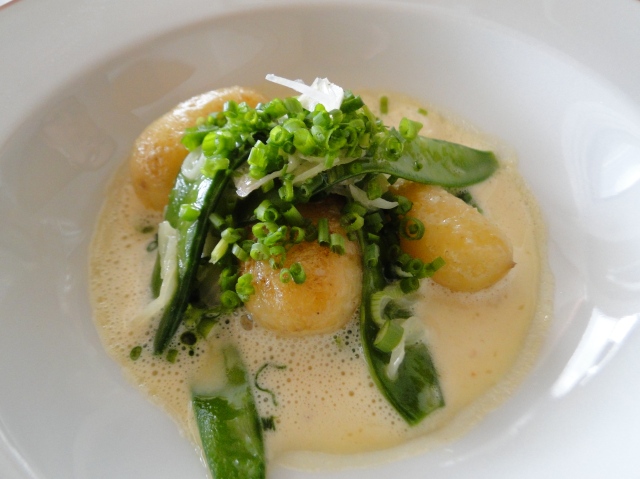
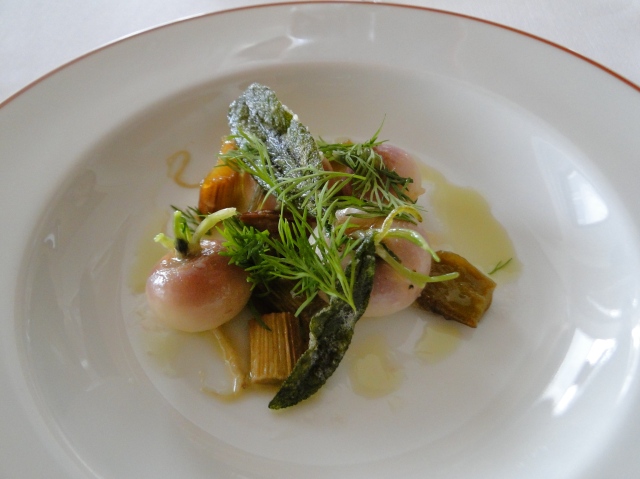
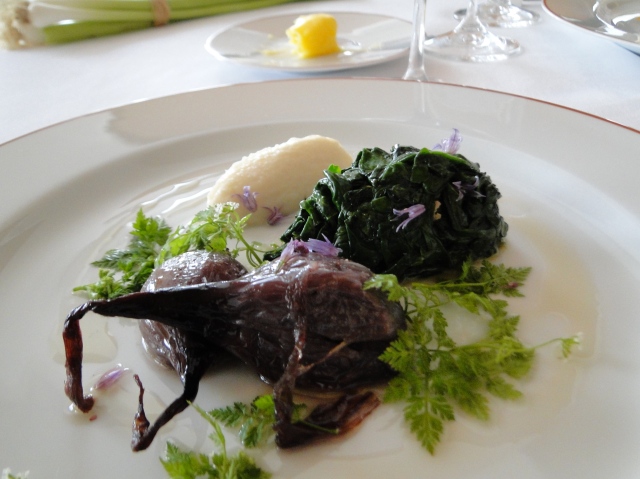
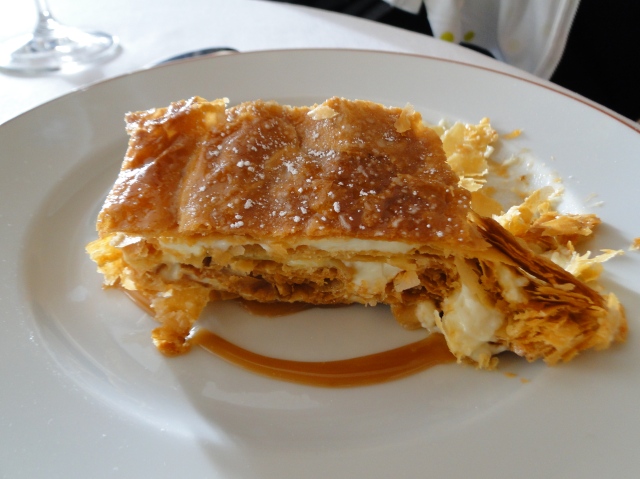
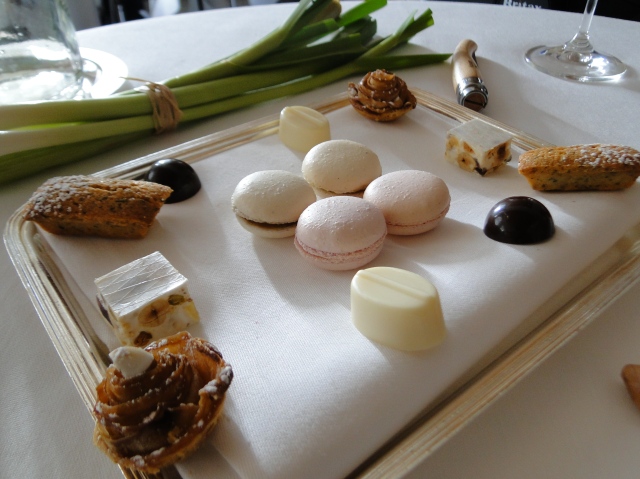
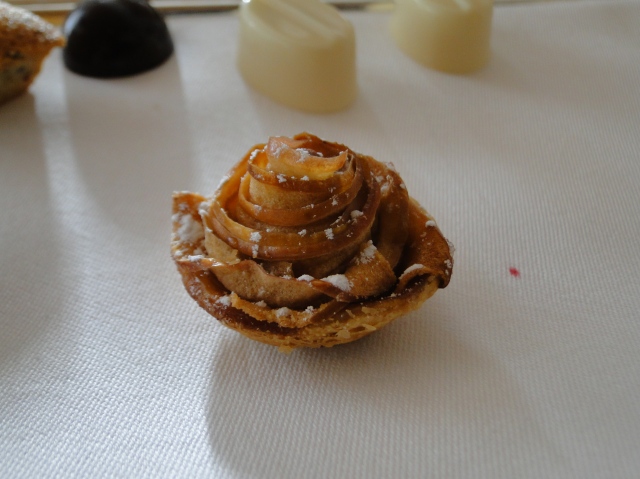
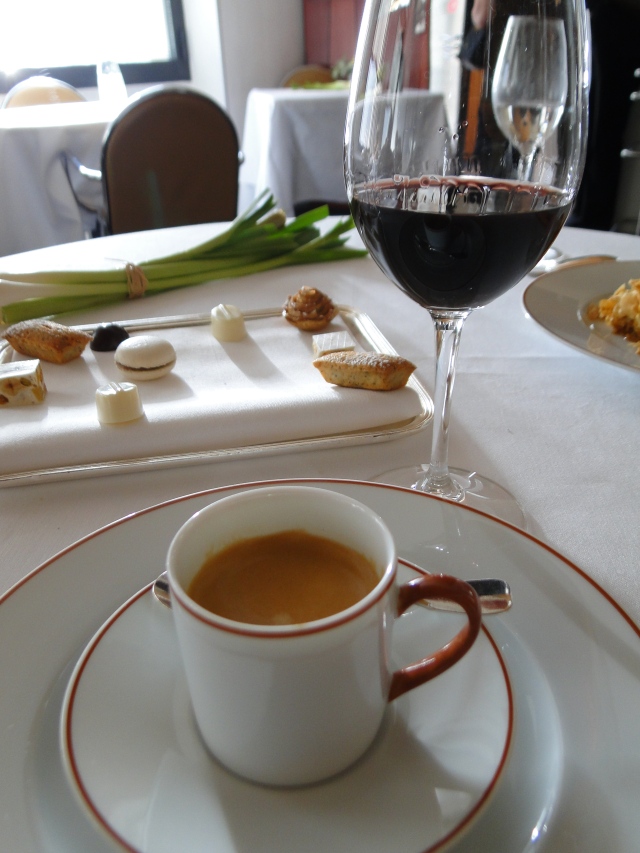


i enjoyed every bit of your culinary journey, albeit vicariously! Having heard talk about the quantity of food, what struk me the most were the desserts. A cheese course, followed by a mille-feuille, followed by the petits fours doesn´t seem balanced. Goat cheese right before a dish focusing on creme and pastry, and followed up by more tiny pastries reminds me of the finale of a 4th of July fireworks display. Remember the bad take on the mille-feuille we had in Santiago?
Ugh, yes, I remember the very poor mille-feuille in Santiago! Why do you think cheese-dessert-petit fours is not balanced? I actually thought it was good (the cheese was light and savory, not sweet, so it didn’t “duplicate” the creamy and sweet mille-feuille.
On Mon, Feb 25, 2013 at 11:48 AM, Without Bacon: The Herbivore's
Pingback: State Bird Provisions — San Francisco, CA | Without Bacon: The Herbivore's Dilemma
Pingback: Might Chevalgate Turn France Flexitarian? | FrenchNewsOnline
It’s being a while I haven’t returned at L’Arpège, but do they still offer the other pricier menus at lunch (on top of the default dejeuner menu that you had)? Thanks
Yes — the prix fixe option I had was “only” €120. There is also a €320 option, and you can order a la carte, which would probably run in the range of €150-200.
Thanks. I can see that their prices haven’t changed for years.
Hm, I wonder if that’s a good thing or a bad thing!
A good thing. I know, we all want great cost performance,but their 120 euros lunch menu, to take an example, sounds fair to me (in light of what is offered). Next time I go there, I’ll try to splurge a bit on the $300+ menu (since I get to visit them only once every 10 years approx) , so cost performance will be certainly weak, and yet when they are in their prime (I had fabulous as well as less impressive meals there in the past), I do not regret. Just hope they are at their best when I’ll revisit them (perhaps next year, hopefully)